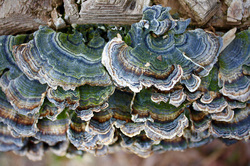
In the environment, fungi are competing with bacteria for nutrients and carbon sources. This competition has resulted in the ability to exploit various ecological niche by different microbes.
- Given a lower surface area to organism size, the fungi are able to deal with nutrient (N,P) scarcity better than may bacteria. They are very efficient in the use of nutrients to build new cell mass.
- Fungi are also able to grow in a wide pH range at levels below ideal for most common soil bacteria.
- Fungi can grow at lower levels of moisture than bacteria.
- Degradation of lignin - many fungi have adapted to fast grown on wood and other plant debris. Many of the enzymes used in degcrading the most recalcitrant portion of plant waste (lignin) also makes these enzymes able to initiate decomposition of complex organics such as DDT, TNT, and may other chlorinated or polyaromatic hydroarbons (PAHs). This non-specific use of the fungal enzymes is done via cometabolism rather than fungal direct action on the waste compounds. The most commonly studies fungi for waste degradation is the white rot wood fungus (Phanerochaete chyrsosporium).
- Fungi typically grow in attached mode which is used for both support and as a substrate for growth. For example, the P. chyrsosporium grows on wood chips when used in bioremediation.
- Most fungi do not do well in suspended growth as found in the water column. This is where bacteria are very efficient at uptake of nutrients, carbon, and oxygen.

 RSS Feed
RSS Feed